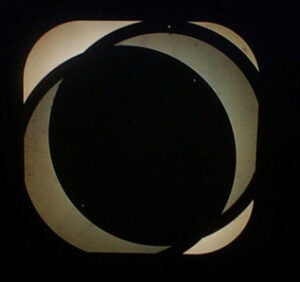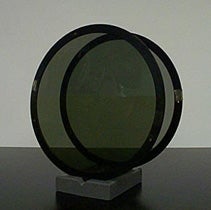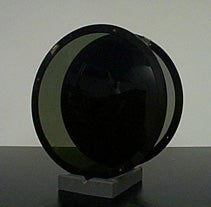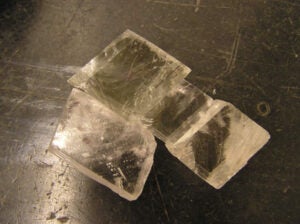O.4(1) – Polarization Filters
A polaroid film is mounted in a circular frame. This linear polarizer is 25 cm in diameter. When observing unpolarized light through two of these polarizers, if they are in the crossed position no light can pass through them, but in the parallel position polarized light is transmitted. Four of them are available. The individual polarizers can be used to observe partially polarized light scattered from a clear tank filled with water and scattering particles.



O.4(2) – Double Refraction
A calcite crystal and Iceland spar crystals are available to demonstrate double refraction. When a narrow light beam, a HeNe laser beam for example, passes through one of those crystals, one can observe the beam split in two projected onto a screen. Polarizing filters show the mutually perpendicular polarization of the split beams.

O.4(3) – Brewster’s Angle: Polarization by Reflection
Light reflected from glass at an angle of 56 degrees is plane polarized, while the refracted light is only partially polarized. A light source and mounts for the polarizers are fitted on moveable radial arms of a turntable with a stand for glass plate on its center. On the turntable, a circular sclae is set and the Brewster’s angle position is already drawn. This large set-up allows easy and clear demonstration of Brewster’s Law or even just the polarizing filters action.

O.4(4) – Red Sunset Experiment
This experiment demonstrates the scattering of light by fine dust and small particles. It mimics the scatttering of sun light by a layer of dust near the earth’s surface causing the sun to appear yellow, then orange, and finally red at sunset.
A high intensity light source is set at one side of a large acrylic tank. At the other side, a large screen is placed, and a black board is set behind the tank. The transmitted light is seen on the white screen and the black background helps to see the scattered light. The solution used consists of 20 grams of sodium thiosulfate per gallon of water plus 1 cc of sulfuric acid which causes the precipitation. After 5 to 10 minutes, the beam reflected through the sides of the tank becomes light blue, while the transmitted light seen on the white screen becomes yellowish and then orange, almost red. With the help of one polarizer filter, one can see the scattered light is partially polarized.